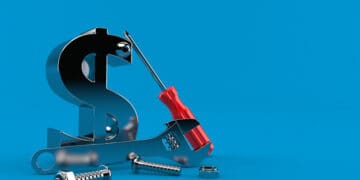- The Best Offense is a Good Defense
- What to Buy for Safety and Long Term Success
- Consumer Staples Stocks
- Unilever (NYSE: UL)
- McCormick and Company (NYSE: MKC)
“Ring out the false, ring in the true.”
— Alfred Lord Tennyson
Happy New Year, everyone.
As we limp into 2023, I’m looking back on what has been one of the strangest and most bewildering years I’ve ever seen.
The stock market had its worst year since the financial crisis of 2009, Elon Musk is tanking Tesla and Twitter simultaneously, and staples like Meta, Microsoft, and Google have been giving up gains like it’s their job.
On the other hand, the oil & gas production industry reported all-time high profits in 2022, certainly benefiting from Russia’s war in Ukraine and the natural gas supply glut throughout Europe.
But overall, if you were investing last year, you are certainly happy to leave 2022 behind you and look forward to greener pastures this year. But as far as I can tell – despite the Dow rising 0.72%, the S&P 500 1.00%, and the Nasdaq 1.37% this morning as I write this – investors should wade in slowly this year and prepare to be a bit defensive as the market shakes out the New Year’s exuberance.
One reason is that the pandemic is still hanging above our heads like the Sword of Damocles. While it is certainly not near the feared grim reaper it has been in years past, I’ve known over a dozen close friends and family that got it in the last few months. The Omicron variant has proven to be the most nimble and transmissible. The CDC just announced that the new kid on the block – XBB.1.5 – has been accountable for the bulk of new infections, rising from 4% to 41% (In the Northeast, where I’m writing from, that number jumps to 75%).
It’s not scaring everyone like it used to, but we’re not out of the woods yet.
So while the second and third acts by the dreaded COVID-19 haven’t been as debilitating, rampant inflation has cooled a bit on the back of the Fed’s interest rate hikes, and worldwide supply chain disruptions have started to untangle, I’m not one to start going all “sunshine and rainbows” on you.
The head of the International Monetary Fund (IMF) just warned that a third of the global economy will be in recession this year. Time will tell, but there is still some fear in the air as we’re waiting on any further Fed moves and take the temperature of a market that spent last year suffering from the flu.
The Best Offense is a Good Defense
During the historic bull market run of the last ten years, the Fed had been propping up the stock market to a large degree. When interest rates were near zero and inflation was eating away at their cash, it left investors nowhere to go for yield except the market. That’s a major reason why we saw such inflows into equities.
But due to the sky-high inflation, the Fed finally decided it was time to start winding down the party. Chairman Jerome Powell implemented seven rapid rate hikes last year. Many experts believe that number will creep up as this new year continues – but certainly not with the speed it did last year.
That’s why I’m looking into safe stocks to begin the year and then pivot to trends and catalysts that should see growth in 2023 and beyond.
Let’s get to it…
What to Buy for Safety and Long-Term Success
You should do two easy things in 2023: diversify your portfolio and make sure you are holding dividend stocks. Over the last decade, my most profitable and consistent wins have come from rock-solid dividend stocks: aristocrats, high-yields, REITs, and MLPs.
Here’s a small snapshot of the gains I cashed out before the pandemic crash of 2020.
• 280% on Sherwin-Williams
• 260% on Abbott Labs
• 112% on Caterpillar
• 100% on T. Rowe Price
• 75% on Service Corporation International
Those are some incredible gains in paint, health care, construction, banking, and funeral services. Pretty diverse, right?
With the market uncertainty persisting, the smart thing to do is go back to the basics. What companies will continue ticking once all of that uncertainty dies down? Let’s go through two dividend stocks that have proven resilient through choppy markets and have sailed strong in calmer seas.
Consumer Staples Stocks
Consumer staples stocks are a sector we all use regardless of market pressures — companies that make food, soap, toilet paper, etc. I’m talking about companies like Procter and Gamble (NYSE: PG), Johnson and Johnson (NYSE: JNJ), and Colgate-Palmolive (NYSE: CL).
These companies have strong organic sales, leading market shares, and attractive dividend yields. Although the industry sees relatively little innovation and growth, consumer staples products tend to be timeless, and these companies are likely to endure.
They are truly set-it-and-forget-it stocks.
Unilever (NYSE: UL)
Unilever (NYSE: UL) is a global consumer goods company that produces things we all use: soap and lotion alongside ice cream, mayonnaise, and condoms. (Wow, now that I read it, that sounds like a very bizarre night if you’re using all those products at once).
Regardless of the economy and the market, Unilever will provide items guaranteed to sell. It also operates worldwide: Asia, Africa, the Middle East, Turkey, Russia, Ukraine, Belarus, the Americas, and Europe.
They have spread out their risk regarding the global economy – all of their eggs aren’t in the U.S. basket.
Axe, Dove, Vaseline, Ben & Jerry’s, Lipton, and Dollar Shave Club are only a sliver of the big-time brands Unilever owns.
Now, Unilever's stock dropped ~6.4% last year, which isn't bad considering how the rest of the market got creamed. That resilience is due in part to some solid fundamentals.
For one, the company has a robust 3.5% dividend yield and a 23-year dividend growth streak. Two more years, and they’ll qualify as a dividend aristocrat. Unilever also has a great return on equity (ROE) ratio of 28%. ROE is a simple formula that shows how well the company reinvests shareholder money. The formula is simple: net profit from continuing operations ÷ shareholders' equity. Anything between 15% and 20% is considered good. 28% is excellent.
Unilever also sports a safe payout ratio of 72% and has a five-year dividend compound annual growth rate (CAGR) of 7.7%.
Here's a glimpse at their Q3 numbers:
- Underlying sales growth accelerated to 10.6% in the quarter, and sales guidance raised for the full year
- Price growth stepped up to 12.5% in the quarter, with volumes declining by 1.6%
- Turnover increased 17.8%, including a currency impact of 8.8% and (2.1)% from disposals net of acquisitions
- The billion+ Euro brands, accounting for more than 50% of Group turnover, grew 14%
These are all solid numbers; I expect them to improve as the fog is lifted from the rate hikes and supply chain issues. I’m confident that Unilever will weather any storms we may have this year and prosper well into the future.
McCormick and Company (NYSE: MKC)
One of my all-time favorite consumer staples stocks is McCormick and Company (NYSE: MKC).
McCormick & Company provides flavorful products to the entire food industry, retail outlets, food manufacturers, and food service businesses. It has around $4.4 billion in annual sales.
Willoughby McCormick started the business with a staff of three in 1889 when he was 25 years old. The company has quietly raised its dividend over the past 37 years, making it a tried and true dividend aristocrat.
While living in Baltimore County during college, I used to wake up to the incredible smells of the McCormick spice factory in Hunt Valley. Some days the air would be permeated with lemon pepper, paprika, or the classic Baltimore smell of Old Bay seasoning, perhaps the most underrated seasoning in America. The largest portion of McCormick’s consumer business is spices, herbs, and seasonings. If you cook, you have some in your house.
The company isn’t all spices, they also have brands like Cholula Hot Sauce, Lawry’s Barbeque, Stubb’s BBQ, and Zatarain's. Their international food brands include Thai Kitchen, Simply Asia, and El Guapo.
And, of course, my all-time favorite: Old Bay.
Editor’s Note: Here in Baltimore, Old Bay is sacred. Not only do we use it on our famed steamed blue crabs, but it is typically found in every restaurant and home for sprinkling on french fries, soups, eggs – pretty much anything and everything. Fun fact, crabs were so abundant in the 1940s when Old Bay was invented that bars in Baltimore offered them free, and seasonings like Old Bay were created to encourage customers to buy more beer.
Aside from those spice, food, and sauce brands, the company also has a robust international flavor market. That includes bulk items for restaurants like flavors, coatings, and branded food service.
You can see the diversification in the pie chart below.
2020 wasn’t a great year for McCormick, as inflation and supply chain issues cut their profit margins. That happened to every food company out there. Their free cash flow has certainly suffered, down to $450 million compared to almost $880 million in 2014.
They have also felt the weight of the debt they took to acquire Reckitt Benckiser – French’s Mustard and Frank’s Red Hot sauce producer – for $4.2 billion.
The stock is down about 14% in the past year, but so is everything else. But look at it over the last ten:
That’s 154% on a simple spice company. If you had reinvested your dividend, you would have banked 203%.
McCormick has just announced another 5% dividend raise — bringing it to a modest 1.88% — which makes me confident they’ll continue to have the ability to pay it out for years to come. It’s a defensive stock but a great long-term holding.
I’d add it to your portfolio after their nearly 20% drop from 52-week highs. It’s not an incredible value stock, but it’s a good stock at a fair price.
Now that we’ve got some of the “boring,” safe stocks out of the way, I’ll be back later this week to look at a couple of higher-yielding dividend stocks that may surprise some investors this year.
I sincerely hope you had a great holiday season and are looking forward to a bright and profitable 2023.
Godspeed,

Jimmy Mengel
The Profit Sector












